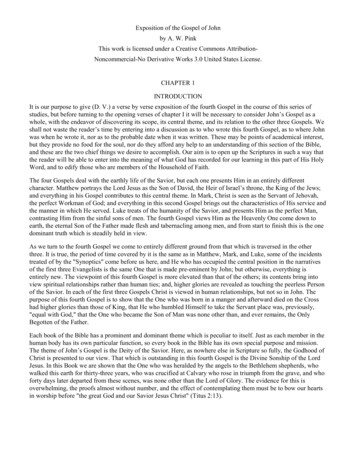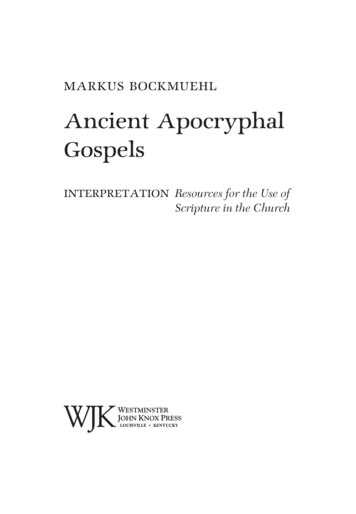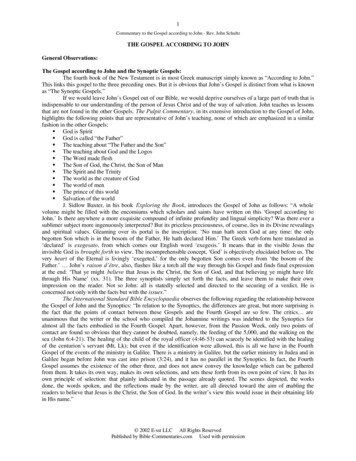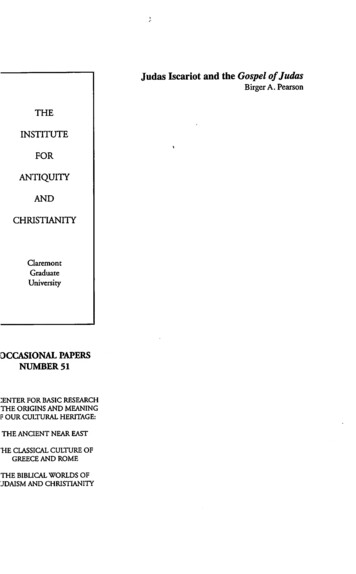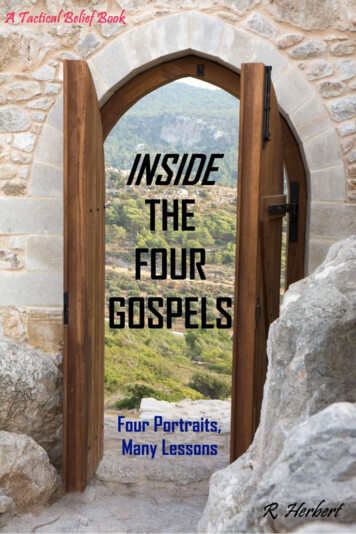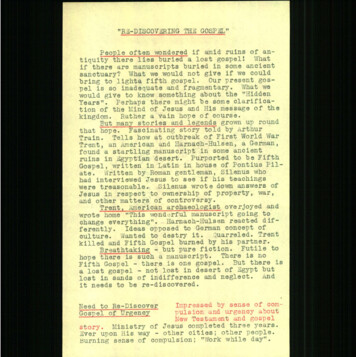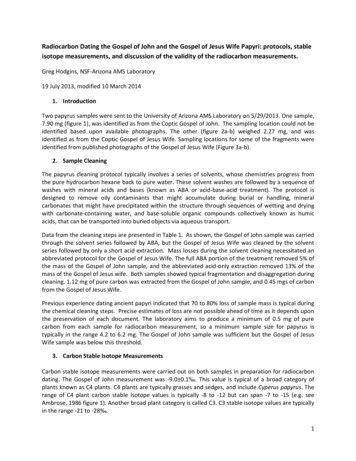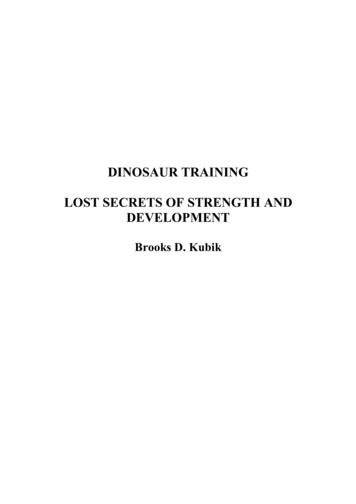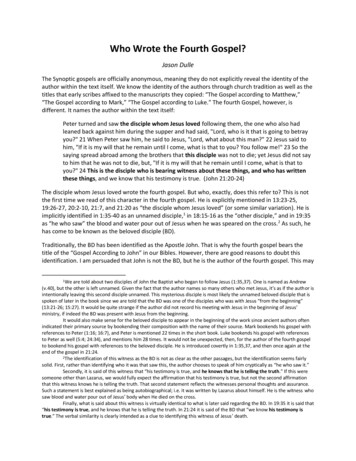
Transcription
Who Wrote the Fourth Gospel?Jason DulleThe Synoptic gospels are officially anonymous, meaning they do not explicitly reveal the identity of theauthor within the text itself. We know the identity of the authors through church tradition as well as thetitles that early scribes affixed to the manuscripts they copied: “The Gospel according to Matthew,”“The Gospel according to Mark,” “The Gospel according to Luke.” The fourth Gospel, however, isdifferent. It names the author within the text itself:Peter turned and saw the disciple whom Jesus loved following them, the one who also hadleaned back against him during the supper and had said, "Lord, who is it that is going to betrayyou?" 21 When Peter saw him, he said to Jesus, "Lord, what about this man?" 22 Jesus said tohim, "If it is my will that he remain until I come, what is that to you? You follow me!" 23 So thesaying spread abroad among the brothers that this disciple was not to die; yet Jesus did not sayto him that he was not to die, but, "If it is my will that he remain until I come, what is that toyou?" 24 This is the disciple who is bearing witness about these things, and who has writtenthese things, and we know that his testimony is true. (John 21:20-24)The disciple whom Jesus loved wrote the fourth gospel. But who, exactly, does this refer to? This is notthe first time we read of this character in the fourth gospel. He is explicitly mentioned in 13:23-25,19:26-27, 20:2-10, 21:7, and 21:20 as “the disciple whom Jesus loved” (or some similar variation). He isimplicitly identified in 1:35-40 as an unnamed disciple,1 in 18:15-16 as the “other disciple,” and in 19:35as “he who saw” the blood and water pour out of Jesus when he was speared on the cross. 2 As such, hehas come to be known as the beloved disciple (BD).Traditionally, the BD has been identified as the Apostle John. That is why the fourth gospel bears thetitle of the “Gospel According to John” in our Bibles. However, there are good reasons to doubt thisidentification. I am persuaded that John is not the BD, but he is the author of the fourth gospel. This may1We are told about two disciples of John the Baptist who began to follow Jesus (1:35,37). One is named as Andrew(v.40), but the other is left unnamed. Given the fact that the author names so many others who met Jesus, it’s as if the author isintentionally leaving this second disciple unnamed. This mysterious disciple is most likely the unnamed beloved disciple that isspoken of later in the book since we are told that the BD was one of the disciples who was with Jesus “from the beginning”(13:21-26; 15:27). It would be quite strange if the author did not record his meeting with Jesus in the beginning of Jesus’ministry, if indeed the BD was present with Jesus from the beginning.It would also make sense for the beloved disciple to appear in the beginning of the work since ancient authors oftenindicated their primary source by bookending their composition with the name of their source. Mark bookends his gospel withreferences to Peter (1:16; 16:7), and Peter is mentioned 22 times in the short book. Luke bookends his gospel with referencesto Peter as well (5:4; 24:34), and mentions him 28 times. It would not be unexpected, then, for the author of the fourth gospelto bookend his gospel with references to the beloved disciple. He is introduced covertly in 1:35,37, and then once again at theend of the gospel in 21:24.2The identification of this witness as the BD is not as clear as the other passages, but the identification seems fairlysolid. First, rather than identifying who it was that saw this, the author chooses to speak of him cryptically as “he who saw it.”Secondly, it is said of this witness that “his testimony is true, and he knows that he is telling the truth.” If this weresomeone other than Lazarus, we would fully expect the affirmation that his testimony is true, but not the second affirmationthat this witness knows he is telling the truth. That second statement reflects the witnesses personal thoughts and assurance.Such a statement is best explained as being autobiographical; i.e. it was written by Lazarus about himself. He is the witness whosaw blood and water pour out of Jesus’ body when He died on the cross.Finally, what is said about this witness is virtually identical to what is later said regarding the BD. In 19:35 it is said that“his testimony is true, and he knows that he is telling the truth. In 21:24 it is said of the BD that “we know his testimony istrue.” The verbal similarity is clearly intended as a clue to identifying this witness of Jesus’ death.
sound contradictory, but only if you assume that the BD is the author of the fourth gospel. I will arguethat the BD is not the author of the fourth gospel, but the primary source used by the author of thefourth gospel. There is compelling evidence to suggest that the BD is Lazarus, and that Lazaruscommitted his recollections of Jesus to writing. John, the author of the fourth gospel, used this writtensource material to compose his gospel. He did not merely publish what Lazarus had written, but editedthe content to construct a truly new piece of literature. John added an introduction and conclusion, andedited Lazarus’ material to fit his literary purposes and construct a well-ordered account of Jesus’ministry and Passion.To make my case, we will examine both the external (evidence outside of the text) and internal(evidence within the text) evidence regarding authorship of the fourth gospel.EXTERNAL EVIDENCETraditionally, the Apostle John has been identified as the author of the fourth gospel. This identificationis largely substantiated by the external evidence. There are two primary sources of external evidence:extant manuscripts and the traditions of the early church.Extant ManuscriptsOur first source of external evidence is the extant manuscripts of the fourth gospel. Every extantmanuscript that still contains the book title attributes the gospel to “John.” The title is contained in atleast seven manuscripts dated prior to the sixth century,3 and reads “gospel according to John” or“according to John.”Early Church FathersThe second source of external evidence is church tradition as preserved in the writings of the earlychurch fathers. They universally agree that the fourth gospel was written by someone named John, butnot all of them specify which John wrote the gospel. Some identify him as the apostle, while othersseem to identify him as John the Elder – another leader of the early church. That is why I qualified mystatement to say that identifying the Apostle John was the author of the fourth gospel is “largelysubstantiated by the external evidence.” Let’s review our earliest sources regarding the authorship ofthe fourth gospel.PapiasPapias was bishop of Hierapolis, near Laodicea and Colossae. He wrote a five-book work titled Expositionof the Logia of the Lord circa A.D. 110. Unfortunately, this work has been lost to antiquity, but fragmentsof it have survived in the quotations of later authors such as Eusebius of Caesarea’s EcclesiasticalHistory. Euesebius quotes Papias as writing:I shall not hesitate also to put into properly ordered form for you everything I learned carefully in the pastfrom the elders and noted down well, for the truth of which I vouch. For unlike most people I did notenjoy those who have a great deal to say, but those who teach the truth. Nor did I enjoy those who recallsomeone else’s commandments given by the Lord to the faith and proceeding from the truth itself. And if3p66( 200), p75 (early 3rd century), Codex Sinaiticus (4th century), Codex Vaticanus (4th century), Codex Alexandrinuscentury), Codex Bezae (5th century), and Codex Washingtoniensis (5th century). In addition to these Greek manuscripts,there are a number of early translations as well including the Sahidic Coptic (3rd century), Curetonian Syriac (3rd/4th century),Fayyumic Coptic (4th century), Achmimic Coptic (4th century), Old Latin (4th century), Proto-Bohairic Coptic (4th/5th century), andMiddle Egyptian Fayyumic Coptic (4th/5th century).(5th
by chance anyone who had been in attendance on the elders should come my way, I inquired about thewords of the elders — [that is,] what [according to the elders] Andrew or Peter said, or Philip, or Thomasor James, or John or Matthew or any other of the Lord’s disciples, and whatever Ariston and the elderJohn, the Lord’s disciples, were saying. For I did not think that information from books would profit me asmuch as information from a living and surviving voice.” (Ecclesiastical History 3.39.3-4)Papias identified four categories of people:1.2.3.4.The eldersThose who heard the eldersJesus’ disciplesAriston4 and John the ElderThe distinction between groups 3 and 4 is important. Papias uses the aorist eipen when speaking ofJesus’ disciples (which, given the names in the list, it’s clear that Papias is referring to the apostles). Theaorist is used for past tense, implying that the apostles were already dead at the time Papias waswriting. However, when Papias speaks of Ariston and John the Elder, he uses the present tense legousin,implying that they were still alive and teaching at the time Papias was writing. That means Papias wasseparated from the apostles in time, but separated from Ariston and John the Elder only by space.5Note that Papias also speaks of two Johns. One is a disciple (apostle) of the Lord and in the category ofthose already dead, whereas the other is identified as “the elder” and in the category of a living voice.John the Elder is not the same person as John the Apostle.6 Papias has not had personal contact withAriston or John the Elder because they are separated by distance, but he has interviewed those whowere disciples of Ariston and John the Elder, and passed on the information he gleaned.The first bit of information Papias communicates is something John the Elder had said regarding theconstruction of the gospels. His purpose in communicating this information was not to identify theauthors or defend authorial origination, but to explain why some of the gospels lacked the sort ofliterary and chronological order typical of other Greco-Roman histories.7 Since there was no apologeticvalue in identifying the authors, there is no reason to believe that Papias was making the authors up.Unfortunately, Eusebius only quoted what Papias said concerning the gospels of Matthew and Mark. Hedid not quote what Papias wrote concerning the gospels of Luke or John. However, there is good reasonto believe that Eusebius may have intentionally omitted Papias’ comments regarding the fourth gospelbecause they conflicted with Eusebius’ own views regarding authorship. Let me explain.Eusebius may have quoted Papias because of Papias’ reference to the two Johns. Eusebius did notbelieve the book of Revelation was canonical. He attributed it to John the Elder rather than John theApostle. Papias established the existence of this other John, who was roughly contemporaneous withthe Apostle John. However, Eusebius did believe that John the Apostle wrote the fourth gospel. Perhapsthe reason he did not include Papias’ comments on the origin of the fourth gospel because Papias saidJohn the Elder claimed authorship of that gospel. In other words, perhaps Eusebius only quoted ofPapias what was useful for confirming his own views of Revelation, but omitted what Papias wrote when4Probablythe first bishop of Smyrna as indicated in the Apostolic Constitutions 7.46.Bauckham, Jesus and the Eyewitnesses: The Gospels as Eyewitness Testimony (Grand Rapids, MI: William B.Eerdmans Publishing Company, 2006), 419.6Bauckham, 17.7Bauckham, 227.5Richard
it contradicted his own views of the authorship of the fourth gospel.8 It is possible, therefore, but by nomeans certain, that Papias affirmed the fourth gospel was written by John the Elder.PtolemyPtolemy, a heretic in the early- and mid- 2nd century, identifies the author of the fourth gospel as “theapostle” in a letter to Flora quoted in Epiphanius:On the other hand, one cannot impute the Law to the injustice of the opposite, God, for it is opposed toinjustice. Such persons do not comprehend what was said by the Savior. For a house or city dividedagainst itself cannot stand [Mt 12:25], declared our Savior. Furthermore, the apostle says that creation ofthe world is due to him, for everything was made through him and apart from him nothing was made [Jn1:3]. Thus he takes away in advance the baseless wisdom of the false accusers, and shows that thecreation is not due to a God who corrupts but to the one who is just and hates evil.” (Epiphanius, AgainstHeresies, 33.3.1 - 33.7.10)Muratorian CanonThe Muratorian Canon ( A.D. 150), which contains our earliest canonical list, seems to identify theauthor as a John other than the apostle:The fourth of the Gospels, that of John, (one) of the disciples. When his fellow-disciples and bishopsurged him, he said: Fast with me from today for three days, and what will be revealed to each one let usrelate to one another. In the same night it was revealed to Andrew, one of the apostles, that, while allwere to go over [it], John in his own name should write everything down. And therefore, though variousrudiments are taught in the several Gospel books, yet that matters nothing for the faith of believers, sinceby the one and guiding Spirit everything is declared in all: concerning the birth, concerning the passion,concerning the resurrection, concerning the intercourse with his disciples and concerning his twocomings, the first despised in lowliness, which has come to pass, the second glorious in kingly power,which is yet to come. What wonder then if John, being thus always true to himself, adduces particularpoints in his epistles also, where he says of himself: What we have seen with our eyes and have heardwith our ears and our hands have handled, that have we written to you. For so he confesses not merelyan eye and ear witness, but also a writer of all the marvels of the Lord in order.The fact that the author makes a distinction between John as “one of the disciples” and Andrew “theapostle” implies that John is not an apostle, but merely a disciple of Jesus and bishop (elder). Dependingon what one makes of Eusebius’ use of Papias, this is either the first or second identification of John theElder as the author of the fourth gospel in the second century.Anti-Marcionite ProloguesAt roughly the same time as the Muratorian canon, anti-Marcionite prologues began to be published.9These were prologues attached to the beginning of the gospels of Mark, Luke, and John. Here is theprologue to John:The Gospel of John was revealed and given to the churches by John while still in the body, just as Papias ofHieropolis, the close disciple of John, related in the exoterics, that is, in the last five books. Indeed hewrote down the gospel, while John was dictating carefully. But the heretic Marcion, after being8Bauckham, 424.9Althoughsome scholars date the prologues to as late as the fourth century.
condemned by him because he was teaching the opposite to him [John], was expelled by John. But he[Marcion] had brought writings or letters to him [John] from the brothers which were in Pontus.Given when Papias lived, the claim that Papias served as John’s amanuensis for the fourth gospel isalmost certainly false. It is interesting, however, that the prologue claims that this is what Papiasclaimed in one of his works (it’s unclear if he is referring to Exposition of the Logia of the Lord or someother work). If that is true, then it would disprove the theory that Eusebius omitted Papias’ informationon the origin of the fourth gospel because Papias claimed it was written by John the Elder.This prologue, however, does affirm that someone named John wrote the fourth gospel. Assuming thatthis John really did expel Marcion, he cannot be the Apostle John. Marcion wasn’t born until A.D. 85110. It is possible, however, that John the Elder was still living when Marcion began his “ministry” andJohn the Elder condemned Marcion. Whether the author of this prologue believed the author of thefourth gospel to be John the Apostle (but had his historical facts all wrong) or John the Elder, cannot bedetermined with any certainty. If we give the author some benefit of the doubt regarding the claim thatJohn condemned Marcion, then John the Elder is the most likely candidate.IrenaeusIn A.D. 180, Irenaeus affirmed the authors of all four Gospels in Against Heresies:Matthew published his own Gospel among the Hebrews in their own tongue, when Peter and Paul werepreaching the Gospel in Rome and founding the church there. After their departure, Mark, the discipleand interpreter of Peter, himself handed down to us in writing the substance of Peter’s preaching. Luke,the follower of Paul, set down in a book the Gospel preached by his teacher. Then John, the disciple of theLord, who also leaned on his breast, himself produced his Gospel while he was living at Ephesus in Asia.(Against Heresies 3.1.1)Irenaeus not only identifies John as the author of the fourth gospel, but also identifies John as the BD.While Irenaeus does not specify which John wrote the gospel in this context, he had previously namedJohn and identified him as an apostle:Now, that the first stage of early life embraces thirty years, and that this extends onwards to the fortiethyear, everyone will admit; but from the fortieth and fiftieth year a man begins to decline towards old age,which our Lord possessed while He still fulfilled the office of a Teacher, even as the Gospel and all theelders testify; those who were conversant in Asia with John, the disciple of the Lord, [affirming] that Johnconveyed to them that information. And he remained among them up to the times of Trajan. Some ofthem, moreover, saw not only John, but the other apostles also, and heard the very same account fromthem, and bear testimony as to the [validity of] the statement. (Against Heresies, 2.22.5)That Irenaeus identifies this John with the apostle is also evident by his synonymous usage of “apostle”and “disciple of the Lord” both before and after the quote in question (1.9.2; 3.3.4).10TheophilusIn A.D. 180, Theophilus of Antioch was the first to unambiguously quote a passage from the fourthgospel and attribute it to someone named John.11 He writes in Apology to Autolycus 2.22, “And hence10Craig11D.1992), 139.L. Blomberg, The Historical Reliability of John’s Gospel (Downers Grove, IL: InterVarsity Press, 2011), 24-5.A. Carson, Douglas J. Moo, and Leon Morris, An Introduction to the New Testament (Grand Rapids: Zondervan,
the holy writings teach us and all the spirit-bearing men, one of whom, John, says, ‘In the Beginning wasthe Word, and the Word was with God.’” Which, John, however, cannot be ascertained.PolycratesPolycrates was bishop of Ephesus in late second century. We only have an excerpt from his writingspreserved in Eusebius, of a letter he wrote to Bishop Victor of Rome ( A.D. 190-195). Polycrates not onlyidentifies the BD as John, but also says that he was a high priest: “John also, he who leaned back on theLord’s breast, who was a priest, wearing the high-priestly frontlet, both witness and teacher. He hasfallen asleep at Ephesus.” (Eusebius, Ecclesiastical History 5.24.2-7).If Polycrates is correct, then the BD whom Polycrates identified as John could not have been the ApostleJohn since there is nothing in Scripture to suggest that the Apostle John was a high priest. Indeed, thereis no historical record of anyone named John serving as high priest in the first century. This John wouldhave had to have been a priest prior to Jesus’ ministry since no disciple of Jesus would have or couldhave been a high priest after Jesus’ resurrection. Surely Polycrates is mistaken. Bauckham thinks thatPolycrates arrived at this conclusion based on an exegetical method rather than historical tradition.Polycrates identified the author of John with the John of Acts 4:6, just as he identified Philip theevangelist with Philip the apostle in another place.12 What’s important for our purposes, however, isthat if Polycrates identified John with Acts 4:6, then he must not have believed that the author of thefourth gospel was the Apostle John. Given the fact that Polycrates’ history seems to be wrong, however,not much can be made of his claims. At best, he perpetuates the tradition that someone named Johnwrote the fourth gospel.Clement of AlexandriaClement of Alexandria, writing A.D. 180, said this of the fourth gospel:Of all those who had been with the Lord, only Matthew and John left us their recollections, and traditionsays that they took to writing perforce . John, it is said, used all the time a message which was notwritten down, and at last took to writing for the following cause. The three gospels which had beenwritten down before were distributed to all including himself; it is said he welcomed them and testified totheir truth but said that there was only lacking to the narrative the account of what was done by Christ atfirst and at the beginning of the preaching . They say accordingly that John was asked to relate in his owngospel the period passed over in silence by the former evangelists. (Eusebius, Ecclesiastical History 3.24.113)In A.D. 200-210, Clement of Alexandria wrote again: “But, last of all, John, perceiving that theexternal facts had been made plain in the Gospel, being urged by his friends, and inspired by the Spirit,composed a spiritual Gospel.” (Eusebius, Ecclesiastical History 6.14.7)Clement does not specify that the Apostle John wrote the fourth gospel, but given the juxtaposition withMatthew as “those who had been with the Lord,” it seems likely that he believed it to be the apostle.OrigenOrigen, in his commentary on Matthew ( A.D. 246-248), writes:Among the four Gospels, which are the only indisputable ones in the Church of God under heaven, I havelearned by tradition that the first was written by Matthew, who was once a publican, but afterwards an12Bauckham, 450-1.
apostle of Jesus Christ, and it was prepared for the converts from Judaism, and published in the Hebrewlanguage. The second is by Mark, who composed it according to the instructions of Peter, who in hisCatholic epistle acknowledges him as a son, saying, “The church that is at Babylon elected together withyou, salutes you, and so doth Marcus, my son.” And the third by Luke, the Gospel commended by Paul,and composed for Gentile converts. Last of all that by John. Why need we speak of him who reclined upon the bosom of Jesus, John, who has left us one Gospel,though he confessed that he might write so many that the world could not contain them? And he wrotealso the Apocalypse, but was commanded to keep silence and not to write the words of the seventhunders. (Eusebius, Eccl. Hist. 6.25.4-6, 9)Origen clearly identifies the BD as John, but it’s not clear as to which John. Again, in his Homilies onJoshua, Origen writes concerning the NT books ( 250 AD):So too our Lord Jesus Christ sent his apostles as priests carrying well-wrought trumpets. First Matthewsounded the priestly trumpet in his Gospel, Mark also, and Luke, and John, each gave forth a strain ontheir priestly trumpets. Peter moreover sounds with the two trumpets of his Epistles; James also andJude. Still the number is incomplete, and John gives forth the trumpet sound through his Epistles; andLuke while describing the deeds of the apostles. Latest of all, moreover, that one comes who said, “I thinkthat God has set us forth as the apostles last of all” [1 Cor 4:9], and thundering on the fourteen trumpetsof his Epistles he threw down, even to their very foundations, the wall of Jericho, that is to say, all theinstruments of idolatry and the dogmas of the philosophers.Once again, Origen identifies the author of the fourth gospel as John, but does not specify if he was theapostle or not. We do know, however, that Origen believed the author of the fourth gospel was also theauthor of the book of Revelation. Since we know Origen believed John the Apostle wrote the latter, itfollows that Origen believed John the Apostle was the BD and wrote the fourth gospel. 13EusebiusFinally, the early third century bishop of Caesarea, Eusebius, had this to say about the fourth gospel:At that time the apostle and evangelist John, the one whom Jesus loved, was still living in Asia, andgoverning the churches of that region, having returned after the death of Domitian from his exile on theisland. And that he was still alive at that time may be established by the testimony of two witnesses. Theyshould be trustworthy who have maintained the orthodoxy of the Church; and such indeed were Irenaeusand Clement of Alexandria. The former in the second book of his work Against Heresies, writes as follows:“And all the elders that associated with John the disciple of the Lord in Asia bear witness that Johndelivered it to them. For he remained among them until the time of Trajan.” And in the third book of thesame work he attests the same thing in the following words: “But the church in Ephesus also, which wasfounded by Paul, and where John remained until the time of Trajan, is a faithful witness of the apostolictradition.” (Ecclesiastical History 3.23.1-4)And again:And in the first place his Gospel, which is known to all the churches under heaven, must be acknowledgedas genuine. That it has with good reason been put by the ancients in the fourth place, after the otherthree Gospels, may be made evident in the following way. Those great and truly divine men, I mean theapostles of Christ, were purified in their life, and were adorned with every virtue of the soul, but wereuncultivated in speech. They were confident indeed in their trust in the divine and wonder-working power13In his Commentary on the Gospel of John, 1:14, Origen writes, “John, son of Zebedee, says in his Apocalypse .” .i.xiv.html.
which was granted unto them by the Savior, but they did not know how, nor did they attempt to proclaimthe doctrines of their teacher in studied and artistic language, but employing only the demonstration ofthe divine Spirit, which worked with them, and the wonder-working power of Christ, which was displayedthrough them, they published the knowledge of the kingdom of heaven throughout the whole world,paying little attention to the composition of written works. And this they did because they were assistedin their ministry by one greater than man. Paul, for instance, who surpassed them all in vigor ofexpression and in richness of thought, committed to writing no more than the briefest epistles, althoughhe had innumerable mysterious matters to communicate, for he had attained even unto the sights of thethird heaven, had been carried to the very paradise of God, and had been deemed worthy to hearunspeakable utterances there. And the rest of the followers of our Savior, the twelve apostles, theseventy disciples, and countless others besides, were not ignorant of these things. Nevertheless, of all thedisciples of the Lord, only Matthew and John have left us written memorials, and they, tradition says,were led to write only under the pressure of necessity. For Matthew, who had at first preached to theHebrews, when he was about to go to other peoples, committed his Gospel to writing in his nativetongue, and thus compensated those whom he was obliged to leave for the loss of his presence. Andwhen Mark and Luke had already published their Gospels, they say that John, who had employed all histime in proclaiming the Gospel orally, finally proceeded to write for the following reason. The threeGospels already mentioned having come into the hands of all and into his own too, they say that heaccepted them and bore witness to their truthfulness; but that there was lacking in them an account ofthe deeds done by Christ at the beginning of his ministry. And this indeed is true. For it is evident that thethree evangelists recorded only the deeds done by the Savior for one year after the imprisonment of Johnthe Baptist and indicated this in the beginning of their account. They say, therefore, that the apostle John, being asked to do it for this reason, gave in his Gospel anaccount of the period which had been omitted by the earlier evangelists, and of the deeds done by theSaviour during that period; that is, of those which were done before the imprisonment of the Baptist. Andthis is indicated by him, they say, in the following words: “This beginning of miracles did Jesus”; and againwhen he refers to the Baptist, in the midst of the deeds of Jesus, as still baptizing in Ænon near Salim;where he states the matter clearly in the words: “For John was not yet cast into prison.” John accordingly,in his Gospel, records the deeds of Christ which were performed before the Baptist was cast into prison,but the other three evangelists mention the events which happened after that time. (Ecclesiastical History3.24.2-8,11-12)Eusebius unambiguously claims that John the Apostle was the author of the fourth gospel.While it’s clear that all early church fathers agreed that someone named John wrote the gospel, some ofthe earliest writers attributed it to John the Elder rather than John the Apostle. If John the Elder was theauthor, perhaps the two Johns became quickly confused by those outside of Ephesus, and laterChristians without intimate knowledge of the history of authorship simply assumed that “John” referredto the Apostle John. 14 It is also possible that those who attributed it to John the Elder were mistaken.The only thing we can know for certain is that everyone thought someone named John wrote thegospel. As such, the external evidence for John’s authorship is on solid footing.INTERNAL EVIDENCENow that we have examined the external evidence for authorship, let’s turn to the internal evidence.Evidence for J
The Gospel according to Mark, _ The Gospel according to Luke. _ The fourth Gospel, however, is . words of the elders — [that is,] what [according to the elders] Andrew or Peter said, or Philip, or Thomas or James, or John or Matthew or any other of

